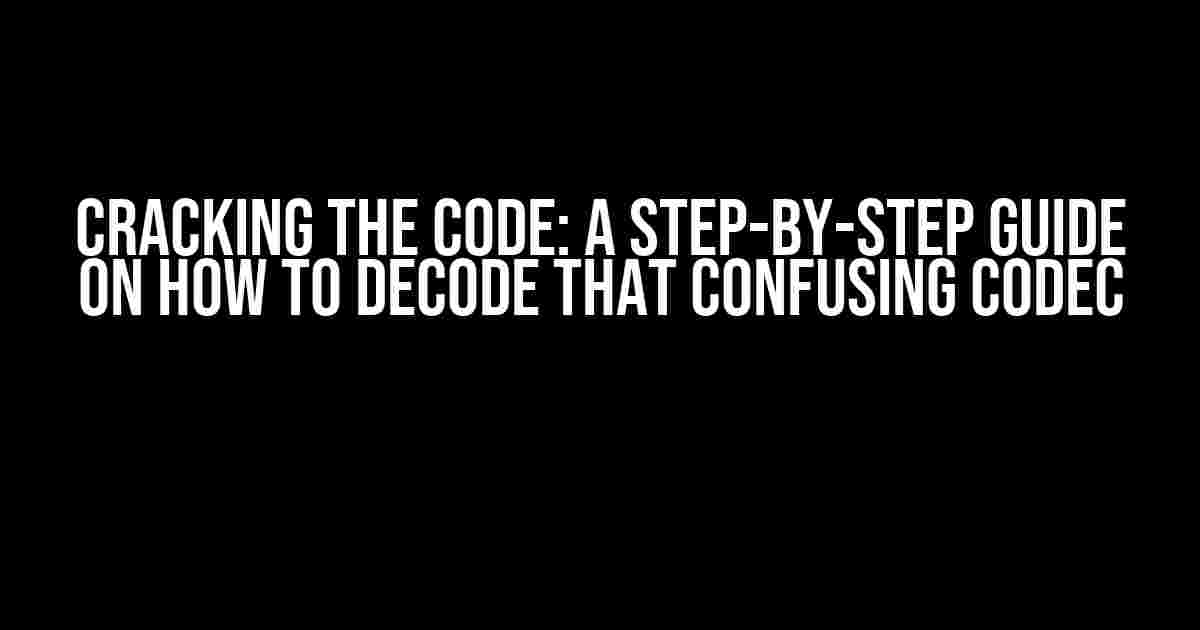Are you tired of being left in the dark, staring at a mysterious codec that refuses to yield its secrets? Do you find yourself wondering, “How can I decode this codec?” Well, wonder no more! In this comprehensive guide, we’ll take you by the hand and walk you through the process of decoding that pesky codec, step by step.
The Basics: Understanding Codecs and Their Purpose
In the vast digital landscape, codecs play a crucial role in making multimedia magic happen. A codec (short for compression-decompression) is a software or algorithm that compresses and decompresses digital data, allowing it to be stored and transmitted efficiently. Think of it as a digital librarian, keeping your files tidy and organized.
Codecs are used for various purposes, including:
- Video compression (e.g., H.264, VP9)
- Audio compression (e.g., MP3, AAC)
- Image compression (e.g., JPEG, PNG)
- Screen recording and streaming
The Problem: Encountering an Unknown Codec
So, you’ve stumbled upon a file with a mysterious codec that refuses to play nicely. You’ve tried everything, from installing codec packs to sacrificing a chicken to the digital gods, but nothing seems to work. Fear not, dear reader, for we have you covered.
Gathering Intel: Identifying the Codec
The first step in decoding a codec is to identify the culprit. You can do this by:
- Checking the file’s properties or metadata
- Using a media player that displays codec information (e.g., VLC Media Player)
- Running a command-line tool like FFmpeg or MediaInfo
ffmpeg -i input_file.mp4This will display information about the file, including the codec used. Take note of the codec name, as we’ll use it later.
Decoding the Codec: A Step-by-Step Guide
Now that we have our codec, it’s time to decode it. Follow these steps:
-
Search for the Codec Online
Head over to your favorite search engine and type in the codec name, along with keywords like “decode,” “playback,” or “converter.” This should yield results from reputable sources, such as codec websites, forums, or tutorials.
-
Install the Necessary Codec or Software
If you find a codec-specific installer or software, download and install it according to the instructions. This will provide your system with the necessary tools to decode the codec.
-
Use a Universal Codec Player or Converter
If installing a codec-specific software isn’t an option, you can try using a universal codec player or converter, such as:
- VLC Media Player
- KMPlayer
- FFmpeg
- Handbrake
These tools can often decode a wide range of codecs, including obscure ones.
-
Check Online Conversion Services
If all else fails, you can try using online conversion services, such as:
- Online-Convert.com
- Convertio.co
- Zamzar.com
These services can convert your file to a more compatible format, often for free.
Troubleshooting Common Issues
Even with these steps, you might encounter some hurdles. Don’t worry, we’ve got you covered:
| Issue | Solution |
|---|---|
| The codec is not recognized | Try reinstalling the codec or software, or search for alternative solutions |
| The file is corrupted or damaged | Try repairing the file using a repair tool or converting it to a different format |
| The decoded file is not playing correctly | Check the file’s metadata and ensure the correct playback settings are used |
Conclusion: Decoding the Mystery Codec
Decoding a mysterious codec might seem like a daunting task, but with the right tools and knowledge, it’s a challenge you can overcome. By following these steps and troubleshooting common issues, you’ll be well on your way to unlocking the secrets of that pesky codec.
Remember, the world of codecs is vast and complex, but with persistence and patience, you can conquer even the most obscure formats. So, the next time you find yourself wondering, “How can I decode this codec?”, you’ll know exactly where to start.
Happy decoding!
Frequently Asked Question
Decoding a codec can be a daunting task, but don’t worry, we’ve got you covered! Here are some frequently asked questions to help you crack the code:
What is a codec, and why do I need to decode it?
A codec (compression-decompression) is an algorithm that encodes and decodes data, often used for audio and video files. Think of it like a secret language that needs to be translated. You need to decode it to play, edit, or view the content. Without decoding, the file remains unreadable and unusable.
How do I determine the type of codec used in my file?
There are a few ways to do this. You can check the file extension (e.g., .mp3, .avi), look for metadata or file properties, or use a tool like FFmpeg or VLC Media Player to analyze the file. You can also try searching online for the file type and codec.
What are some common codecs used in audio and video files?
Some popular codecs include MP3 (audio), H.264 (video), AAC (audio), and VP9 (video). There are many others, but these are some of the most widely used. Knowing the specific codec used in your file will help you choose the right decoder or software.
Can I use online tools or software to decode my codec?
Yes, there are many online tools and software available that can help you decode your codec. FFmpeg, Handbrake, and VLC Media Player are popular options. You can also search for online converters or decoders specific to your file type and codec. Be cautious when using online tools, as some may have limitations or security risks.
What are some tips for decoding a codec successfully?
Make sure you have the correct decoder or software for your file type and codec. Follow the instructions carefully, and be patient, as decoding can take time. If you encounter errors, try updating your software or seeking help from online forums or communities. Don’t be afraid to ask for help if you’re stuck!


